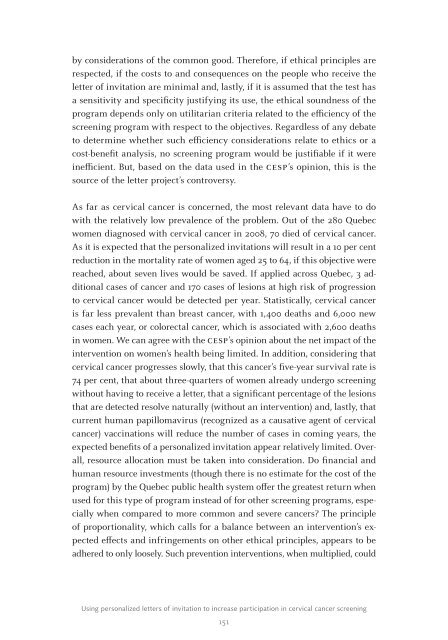PoPulationand Public HealtH etHics
PoPulationand Public HealtH etHics
PoPulationand Public HealtH etHics
You also want an ePaper? Increase the reach of your titles
YUMPU automatically turns print PDFs into web optimized ePapers that Google loves.
y considerations of the common good. Therefore, if ethical principles are<br />
respected, if the costs to and consequences on the people who receive the<br />
letter of invitation are minimal and, lastly, if it is assumed that the test has<br />
a sensitivity and specificity justifying its use, the ethical soundness of the<br />
program depends only on utilitarian criteria related to the efficiency of the<br />
screening program with respect to the objectives. Regardless of any debate<br />
to determine whether such efficiency considerations relate to ethics or a<br />
cost-benefit analysis, no screening program would be justifiable if it were<br />
inefficient. But, based on the data used in the CesP’s opinion, this is the<br />
source of the letter project’s controversy.<br />
As far as cervical cancer is concerned, the most relevant data have to do<br />
with the relatively low prevalence of the problem. Out of the 280 Quebec<br />
women diagnosed with cervical cancer in 2008, 70 died of cervical cancer.<br />
As it is expected that the personalized invitations will result in a 10 per cent<br />
reduction in the mortality rate of women aged 25 to 64, if this objective were<br />
reached, about seven lives would be saved. If applied across Quebec, 3 additional<br />
cases of cancer and 170 cases of lesions at high risk of progression<br />
to cervical cancer would be detected per year. Statistically, cervical cancer<br />
is far less prevalent than breast cancer, with 1,400 deaths and 6,000 new<br />
cases each year, or colorectal cancer, which is associated with 2,600 deaths<br />
in women. We can agree with the CesP’s opinion about the net impact of the<br />
intervention on women’s health being limited. In addition, considering that<br />
cervical cancer progresses slowly, that this cancer’s five-year survival rate is<br />
74 per cent, that about three-quarters of women already undergo screening<br />
without having to receive a letter, that a significant percentage of the lesions<br />
that are detected resolve naturally (without an intervention) and, lastly, that<br />
current human papillomavirus (recognized as a causative agent of cervical<br />
cancer) vaccinations will reduce the number of cases in coming years, the<br />
expected benefits of a personalized invitation appear relatively limited. Overall,<br />
resource allocation must be taken into consideration. Do financial and<br />
human resource investments (though there is no estimate for the cost of the<br />
program) by the Quebec public health system offer the greatest return when<br />
used for this type of program instead of for other screening programs, especially<br />
when compared to more common and severe cancers? The principle<br />
of proportionality, which calls for a balance between an intervention’s expected<br />
effects and infringements on other ethical principles, appears to be<br />
adhered to only loosely. Such prevention interventions, when multiplied, could<br />
Using personalized letters of invitation to increase participation in cervical cancer screening<br />
151
















